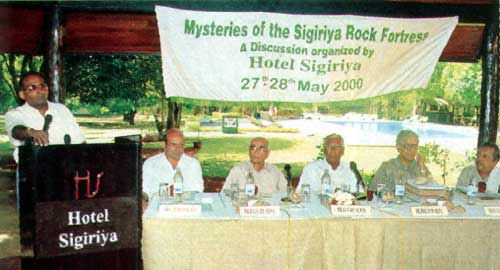Sigiriya: Cultural Asset or Disneyland?
 |
 |
by Nalin Fernando
Half a dozen erudite specialists probed the mysteries of the Sigiriya rock fortress at a seminar held last weekend at the Hotel Sigiriya and their dissertations were heard and later dissected by about a hundred special invitees.
The line of experts, as awesome as the rock in the background of the podium from which they spoke, delivered diverse data-saturated views mostly catering to the professorial and scientific minds, spawning a certain amount of controversy among themselves and an audience associated with ecology, environment protection, conservation and cultural heritage.
There were also plenty of varied historical, architectural and archaeological disclosures relating to the monumental rock. And when the jawing was over, moderator Lyn di Alwis, former zoo and wild life commissar, thanked the gods for not allowing the mysteries of the rock to be solved that easily and hoped that the hospitable Hotel Sigiriya would sponsor another enjoyable weekend to probe the enigma further.

|
|
Scene from the film God King
|

|
|
Filming God King atop Sigiriya
|

|
|
Set of the film God King
|
But what was comprehensible to almost everyone present was that Sigiriya, a national archaeological and cultural asset, was in the danger of becoming a Disneyland.
According to Central Cultural Fund sources, in 1999 close to 700,000 local tourists and about 12,000 foreigners threaded the narrow spiral stairway to view the frescoes and trudged to the top to gawk at the excavations of a monastery (according to Dr. Raja de Silva, former Archaeological Commissioner) or a palace (according to Prof. Nimal de Silva of the University of Katubedde). And on any long weekend with a poya included about 30,000 locals will kneel in pious and subtined worship at the nearby Dambulla Vihare arill proceed to Sigiriya to unwind, often with the assistance of a three-in-one and a "deck piece".
And as Mr. Abbas Esufally, managing director of Serendib Leisure which manages the host Hotel Sigiriya gingerly suggested (wary, last he trod on official corns) in his closing remarks, a few dust-bins and urinals around the base of the rock will prove useful to the vast moving population. If the ungainly sight of litter and the pervading odour of ammonia is a threat to the surroundings, what about disastrous effect of over-exposure of carefully conserved antiquities?
Although not scientifically confirmed, there is a strong suspicion that the heavy concentration of human beings, exuding salty body vapour near and around the famous frescoes is the cause of the recently reported fungus growth on the paintings. But there is no doubt among some conservationists that vibration caused by clambering up the iron spiral stairway and tramping on the iron viewing platform is certainly not healthy for the preservation of the delicate paintings.
Everybody present agreed that restricting nationals, whether they be aesthetes, scholars or deviants, from gazing at the bare-breasted beauties would amount to human rights violation. But is there no subtle side-stop to curb visitation, especially by those who want to treat a grip to Sigiriya more as a pleasure-outing than a scholarship?
Former Archaeological Commissioner Dr. Raja de Silva says that up to about 1986 which time he Was associated with the monument, only five members of the public were allowed on the viewing platform at any given moment. Now a dozen or more crowd and clamber up the stairway and on to the platform and there is an ever present danger of the contraptions collapsing one day. However, there is a precedent about restricting viewing.
The diminutive but bold archaeological chief, the late Prof. Senarath Pananavitane, clamped a ban on viewing the frescoes for six long years in the late forties and early fifties while conservation work was carried out. There was no outcry about human rights then.
The hoteliers in the area and the tourist authorities don't like the word restriction whether it applies to locals or foreigners. But they are concerned that any deterioration or destruction of Sigiriya will affect them. They favour control since there are enough other archaeological, cultural and ecological attractions in the area for the foreign tourists and the local visitors. They cite the restored royal gardens, ponds, fountains and temples at the base of the rock for the casual visitor and the frescoes, inscriptions and excavated structures for the student of conservation and archaeology.
And who suggested that replicas of the original paintings and inscriptions should be on display nearby for the visual delectation of the weekend visitor and the charter tourist while the original be spared for the certified scholar? And who said that local visitation would be halved if the women in the paintings wore a bodice or a medieval brasiers?
And who thought aloud that in this world all is impermanent and so are the frescoes and the ancient pillars?
The consensus of opinion that weekend, however, was that the waste of Sigiriya, whether it be the deterioration of the frescoes or the erosion of the rocky pathways, has to be curbed. Otherwise in the years ahead there will be no rock fortress of repute to be discussed by the likes of Dr. Shiran Deaniyagala, Director General of Archaeology, Dr. Roland Silva, founder Director General of the Central Cultural Fund. Mr. Manik Sandrasagra, founder of the Cultural Survival Trust of Sri Lanka, Mr. Ashley de Vos, Chartered Architect, Dr. Raja de Silva and Prof. Nimal de Silva, the last two named being introduced earlier.
Courtesy: The Sunday Observer of 4 June 2000
The Sacred Secrets of Sigiriya: Mysteries of the Sigiriya Rock
Former Archaeological Commissioner Raja de Silva's response "Archaeological Department, Central Cultural Fund and the Law"
"Curtains for Sigiriya Rock Concert"
"Dispute brewing over 'Sigiriya Evening Walk'"
"The Sigiriya Rock Show"
"Selling culture - the Sigiriya issue"
Sigiriya.org home
Sigiriya.org home
|
| Living Heritage Trust ©2021 All Rights Reserved |